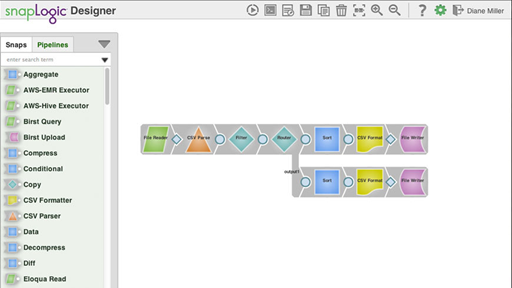Have you ever wished that enterprise integration were as simple as snapping together LEGO Blocks? That’s the vision of San Mateo, California-based SnapLogic. The brainchild of Informatica co-founder Guarav Dhillon, SnapLogic offers a novel take on Integration-as-a-Service that is both Cloud-friendly as well as user-friendly. SnapLogic works both on-premise and in the Cloud – but don’t let the on-premise option fool you. This is no traditional integration product warmed over for the Cloud. Instead, SnapLogic is architected first and foremost for the Cloud while supporting hybrid as well as behind-the-firewall integration scenarios, making it a modern, enterprise-ready integration solution.
 While Dhillon cut his teeth on Extract-Transform-Load (ETL) approaches to integration at Informatica, SnapLogic moves past both this “bulldozer” approach to integration as well as the centralized, stateful “bus” approach that Enterprise Service Buses represent. Instead, the Cloud requires elasticity, stateless processing, and in Big Data situations, moving the logic to the data (what the industry has taken to calling the Data Gravity problem) – all requirements that SnapLogic addresses. However, while the enterprise-class integration technology under the covers is central to supporting customers’ business agility requirements, it’s the SnapLogic Designer tool that is downright sexy. Even so, this slick, streamlined interface is more than eye-candy, as it opens up previously complex integration tasks to a wider range of users, both simplifying and extending the power of the platform.
While Dhillon cut his teeth on Extract-Transform-Load (ETL) approaches to integration at Informatica, SnapLogic moves past both this “bulldozer” approach to integration as well as the centralized, stateful “bus” approach that Enterprise Service Buses represent. Instead, the Cloud requires elasticity, stateless processing, and in Big Data situations, moving the logic to the data (what the industry has taken to calling the Data Gravity problem) – all requirements that SnapLogic addresses. However, while the enterprise-class integration technology under the covers is central to supporting customers’ business agility requirements, it’s the SnapLogic Designer tool that is downright sexy. Even so, this slick, streamlined interface is more than eye-candy, as it opens up previously complex integration tasks to a wider range of users, both simplifying and extending the power of the platform.
Snaplex: At the Heart of Cloud-Centric Architecture
SnapLogic architected its “Integration Cloud” following the model of Software-Defined Networking, which separates message interactions into a control plane and a data plane. SnapLogic hosts its control plane in the Amazon Web Services (AWS) Cloud. This component consists of the Designer, Manager, and Dashboard subcomponents, which manage the data plane. The control plane handles load balancing, security, task scheduling, and metadata management for the Integration Cloud.
At the core of the data plane is the Snaplex (or in reality, multiple Snaplexes). Snaplex is the data processing component of the Integration Cloud, and it comes in two flavors: the on-premise Groundplex and the in-Cloud Cloudplex. The Groundplex provides on-premise connectivity behind the corporate firewall, while SnapLogic preconfigures the Cloudplexes in the Integration Cloud.
Each Snaplex is inherently elastic, and the control plane can automatically scale the Snaplexes out or in as needed. As each Snaplex is a stateless processor, such scaling takes advantage of the partition tolerant nature of Cloud environments. This architectural choice on the part of SnapLogic is central to their product differentiation, as traditional middleware products do not cleanly separate the control and data planes, and thus have no way to perform elastic, stateless processing in the Cloud. You can’t simply take a traditional integration tool, stick it in the Cloud, and expect it to take advantage of the unique benefits that the Cloud provides. Instead, Integration-as-a-Service capabilities require a ground-up rethink of integration. SnapLogic has been down this road, and as a result, their product offers this advanced set of capabilities.
SnapLogic Designer: Integration as Simple as LEGO Blocks
Many of today’s integration tools have slick user interfaces, but SnapLogic took extra care to make theirs user-friendly for both deeply technical and casually technical audiences alike. Each element is a Snap, and the Snaps snap together with a pleasant click sound. The connector symbols on the end of each Snap refer to other Snaps it can connect to (document or binary). Configuring each Snap is a simple matter of clicking on it and entering basic configuration information. SnapLogic Designer appears in the figure below.

SnapLogic ships with over 160 pre-built Snaps (and an SDK to build new ones), making integration a snap (pun intended).
The Intellyx Take
SnapLogic Designer doesn’t simply present a seamless user interface; it offers a powerful abstraction. Abstractions are intentional simplifications that hide underlying capabilities, and in the case of SnapLogic, the capabilities under the covers are where the real power lies. Remember, SnapLogic integrates on-premise and Cloud-based resources while supporting the full elasticity of the Cloud environment – a complicated challenge for any application. Don’t let the simplicity and friendliness of the user interface fool you. This is a powerful, enterprise-class tool.
Abstractions are also at the core of the Bloomberg Agile Architecture™ (BAA) Technique, which recommends that application creators (and integrators) work at the abstract model level. The role of the abstract model in the BAA Technique is both to present a simplified modeling capability to users while abstracting real-time resolution of API contracts and data formats. For tools that are able to implement this capability, the result is inherently flexible integration that responds to changes in APIs dynamically in real time.
SnapLogic clearly has the simplified modeling capability that facilitates the BAA Technique. Furthermore, SnapLogic does not require a fixed schema for an API interaction (except where the API requires it to be fixed), and SnapLogic allows the schema to be flexible so that integrations don’t break when any changes in the API requests and responses take place. When critical changes occur, SnapLogic handles them as a graceful degradation. If any references are made to schema fields which may no longer exist in the data flow, SnapLogic ensures that failures don’t cause unforeseen errors.
In most circumstances, SnapLogic’s approach to API change won’t present much of a limitation, as the platform separates the design time aspects of creating and configuring integrations in the Designer from the run time aspects that the Snaplexes handle. Far more important is SnapLogic’s ability to elastically scale out and in, thus supporting changing capacity requirements – an essential enabler of business agility for any enterprise moving to the Cloud.
Intellyx has no business relationship with SnapLogic at the time of writing.




Comments